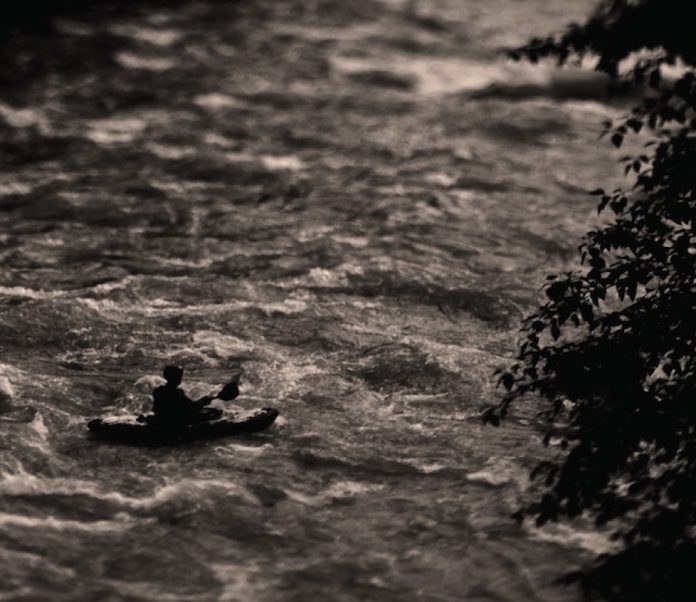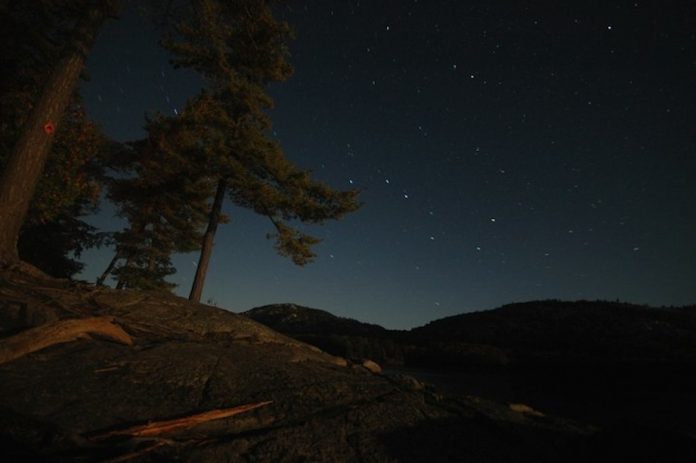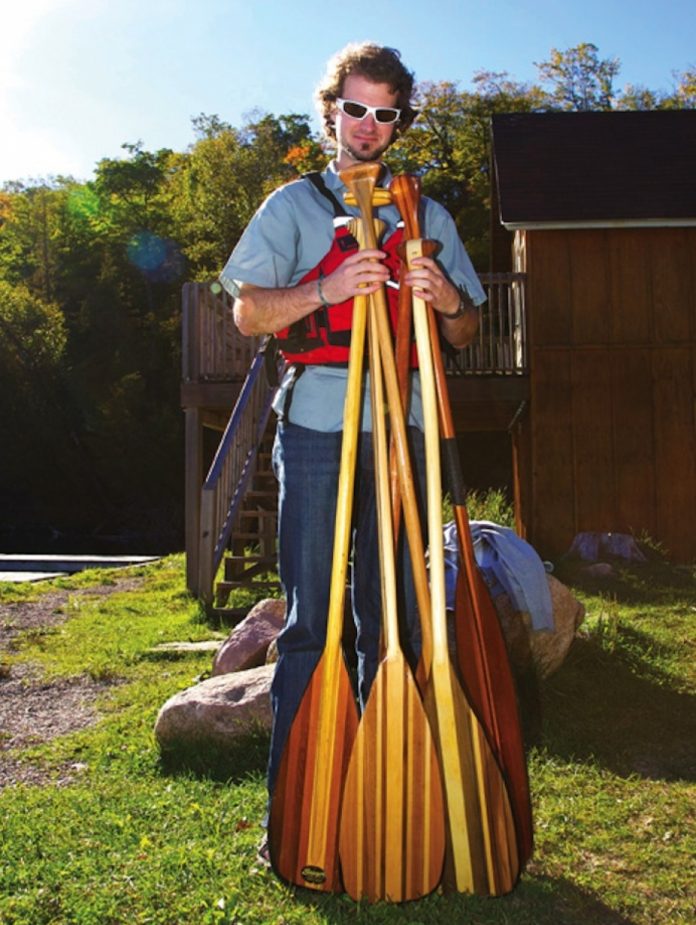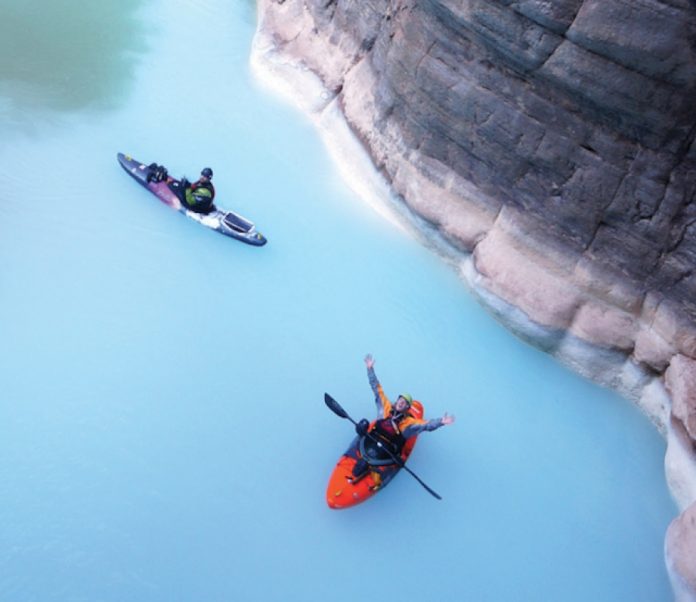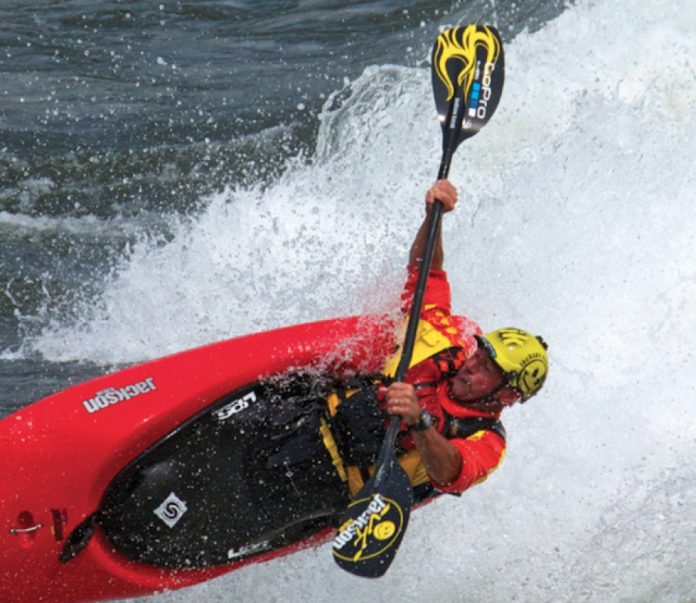Steve Wagner shows us all the neat design features of the new PFD from Salus, The Proto. If you are looking for a rescue vest and something you can strip down to play in, check this out.
Video: New Gear From NRS
NRS has so many things to show Scott from Rapid Media that they don’t quite get to it all before the duck starts quacking. Watch the video and it will all make sense.
Video: New Sawyer Paddles
Canoeroots TV grabs Pete Newport from Sawyer Paddles and Oars at Outdoor Retailer to tell us what the Sawyer Racing team is all about. He fills us in and shows us some of the paddles that are designed to be light, look great and make you go fast.
Video: New Pack Canoe from Old Town
Publisher of Canoeroots Magazine Scott MacGregor is shown the new Old Town Pack Canoe by director of R & D Bob McDonough. Find out why this design gives you some of the benefits of both a kayak and canoe.
Core Kirri WW Bent Shaft Review
The new kid on the block, Core Paddles is poised to take the market by storm. With the introduction of one-piece Easton Elite alloy shafts combined with carbon composite blades, Core has put the notion of aluminum paddles being low budget to rest. The Kirri is Core’s premier whitewater product and it’s lighter, stronger and more durable than most full carbon paddles. Grips on the shaft eliminate slippage and the optional 12- or 30-degree offset lets you choose your angle
corepaddles.com | $449
This article originally appeared in Rapid magazine, Early Summer, 2011. Download our free iPad/iPhone/iPod Touch App or Android App or read it here.
Off the Tongue: Brother Down
I didn’t know Jeff West. Jeff died this summer attempting the first solo, one-day descent of the Grand Canyon of the Stikine River. I didn’t know Lynn Clark either. Lynn died 14 years ago this February at Little Picky on the Ottawa River. She was out for an afternoon paddle with friends. She was swept and trapped under ice. I attended Lynn’s memorial service, although I’m not exactly sure why. Paddlers were lined up out the door and down the street of the funeral home. I don’t remember saying anything to her family and close friends at the front. I’m not sure anything any of us could have said would have mattered. Lynn was an accomplished paddler and award-winning paddling filmmaker out for an afternoon with friends and then she was dead. What the hell was she thinking paddling then and there? How did she flip? Why didn’t she roll? Standing in line at a funeral home is not the time or the place to ask such questions.
If she’d not died, she’d have gone for a greasy pizza at the Country Kitchen and today she’d likely be paddling’s most celebrated filmmaker. If Jeff West was successful, he too may have gone for pizza and been famous, although being famous was not his was not his thing. What drove him to attempt back-to-back runs on the most extreme river in the world? Only Jeff knew for sure.
A REMINDER THAT RIVERS HAVE HORNS
It’s easy to ask questions and form opinions. It’s tempting to weigh-in to online debates. Certainly many have. It is a natural part of our grieving process. It’s part of the collective trying to figure out how shit like this happens. Searching for answers in tragic accidents can make a falsely comforting list of why it hasn’t happened to us.
I’ve not paddled the Stikine. I don’t know the lines or the levels. I don’t know how pumped I’d feel after a successful attempt. I do know however that I have cartwheeled on Christmas Eve day, a short swim above an otherwise frozen river.
As kids, when my brother and I would pick at my dad, he used to say, “If you mess with the bull, you’ll get the horns.” He meant of course, if you keep doing something dangerous, you will eventually get hurt. We’d keep at him until we got the horns, in this case just a good tickling. Getting the horns was all part of the game. When paddlers die, we remember that rivers have horns.
When we lose paddlers to rivers, the best we can hope for is a raised awareness of the true risks. The facts of tragic river accidents provide the framework for self-assessment. The facts help us understand why we haven’t gotten the horns. And if we’re truly honest with ourselves, the facts are a list of why we very well could.
Let’s remember great paddlers and friends for who they were and for all they’ve given us. Lynn Clark taught me to stay off icy rivers. For that, I’m forever grateful.
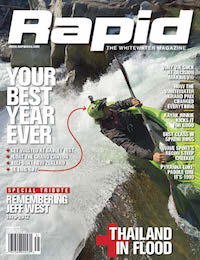 This article first appeared in the Spring 2013 issue of Rapid Magazine. For more great content, subscribe to Rapid’s print and digital editions here.
This article first appeared in the Spring 2013 issue of Rapid Magazine. For more great content, subscribe to Rapid’s print and digital editions here.
Elemental: No Pain, No Gain
There was one moment in each of my favorite trips where I stopped and thought to myself, “What the hell am I doing here?” It’s happened on a portage that climbed and climbed, during a week of rain that resulted in trench foot, when barely making headway in 120-kilometer-an-hour winds, or, quite literally, just being a stranger in a strange land. It’s that undeniable, holyshit- I’m-in-over-my-head moment of total discomfort. Not to be confused with the sickening lurch of a backcountry, “Uh oh.”
On every trip that’s meant something to me—really meant something—there’s always a moment where I stepped so far outside my comfort zone that a panicky, almost painful sensation entered mychest. Hours of pushing an 80-pound bike weighed down with camping gea up a steep Cape Breton road, only to crest it, enjoy a short-lived, white-knuckle 70-kilometer-an-hour descent and do it all again. A 30-kilometer day in a weeklong hike through Torres del Paine, where, only two-thirds of the way there by late afternoon, I threw off my pack, fell onto my back and raised swollen feet to the sky in absolution. Standing in the Wabakimi landscape I’d been tracing on a map in my living room for months, watching the floatplane disappear…
This article appeared in Canoeroots & Family Camping, Spring 2013. Download our free iPad/iPhone/iPod Touch App or Android App or read the rest here.
The Perfect Paddle Size
At summer camp, sizing a paddle was as easy as grabbing one that stood at my toes and touched my nose. As adults with greater attention spans and finer attention to details, most of us now seek a more precise fit that combines hand position, the distance from the lower hand to the water and blade length.
Most people begin their quest using the bent arm technique: holding the paddle on your head with your arms at 90-degree angles. A better method is to go paddling and mark your most comfortable and common lower hand position.
Your position in the boat, and the boat itself, changes the desired paddle length. For example, if you paddle with the boat heeled way over and your lower hand at water level; your hand will be at the top of the blade, or throat, of the paddle. In this case, the ideal paddle length is simply your bent arm length added to whatever blade size you prefer.
However, trippers generally prefer to paddle with their lower hands dropping just below the gunwale. Furthermore, whitewater paddlers actually keep their lower hands above the gunwale. Not to mention that kneeling versus sitting, two weeks worth of gear, bow or stern positions and sitting low in a performance touring canoe all change the distance from your lower hand to the waterline.
The most precise sizing method I’ve found gets you in your canoe on the water with a broomstick. You pretend to paddle as you normally would. The part of the stick that remains dry is your ideal shaft length in this canoe. This method accounts for your hand position, seat height, depth of the canoe and paddling style, requiring only the addition of your preferred blade length.
I have different length paddles for whitewater C1, slalom, classic solo paddling and tripping. The only thing that remains pretty much the same is my hand position. In each case it took trial and error to figure out what works best for me.
This article originally appeared in Canoeroots & Family Camping, Spring 2011. Download our free iPad/iPhone/iPod Touch App or Android App or read it here.
Paddle Your Own Epic
It’s day eight and we’ve reached Lava Falls, arguably the largest rapid in the Grand Canyon. Overhead, the sun is blinding. The canyon is a chameleon and has changed its look again, opening up to a panoramic desert view. Just yesterday, we were paddling with icicles forming on our helmets. The cold front that lingered for days is f inally gone. As we float closer, our anticipation heightens. Most of us take the scenic hike up river right to scout. Even from up here, it still looks big. After watching a few in the group style the rapid, the rest of us head down to our respective boats. One after another, we peel out.
Any self-supported kayak trip, let alone one down the Grand Canyon, is an adventure of a lifetime. Although more common in recent years, remote multi-day whitewater trips are still a relative rarity amongst everyday paddlers and are usually reserved for epic first descents in far-off destinations. There are many rivers in the United States perfect for a multi-day trip, and it’s easier than you might think. In January, I paddled the Grand Canyon self-supported—instead of having rafts or larger crafts haul gear, we packed our kayaks to the brim with everything needed for weeks on the water, and I do mean everything. It’s not just paddling gear and rescue gear, but food and a cook stove, tents and sleeping bags, and, everyone’s least favorite, the groover. Once you’ve established your route, here’s how to do everything else.
Heavy Hitter
The first step is to find your vessel. Look for a crossover boat. My boat of choice was the Pyrahna Fusion, a whitewater boat that allowed me to pack 20 gallons of gear in a dry storage hatch in the stern, fit a little more in the bow and still paddled well.
Even with such a big load, your kayak will handle fine, but you will feel the additional weight. What you lose in maneuverability, you’ll make up for with driving force. You’ll feel like you can blast through any rapid. The Colorado is big water with relatively few obstacles. There are certainly some large holes, but for the most part it’s large waves—perfect for a loaded boat. Since the rapids don’t require too much maneuvering, we were able to paddle the river with our skegs down. The skeg, traditionally used for staying straight and fast in flatwater, proved to be equally useful in the rapids.
Chow Down
Expect to work on a self-supported trip and pack for burning extra calories. Kayakers usually paddle in 10 to 14 days what rafts take upwards of 20 days to do. Add in the amazing side hikes and you know your entire body is going to be fatigued by day’s end. Proper nutrition and hydration becomes of utmost importance to ensure you don’t become a liability to your group members.
As for what kind of food to bring, think classic river snacks. You need items that can be packed into your boat as efficiently as pos- sible. Lightweight, non-perishable items are the target. Peanut butter, oatmeal, bagels, tortilla wraps, jerky, dried fruit, trail mix, rice and bean packets, pasta and Clif bars are just a few common items. Blocks of cheese, tuna and dehydrated meats are also good choices. Watch out for spoilage in meats and cheeses, especially if you’re paddling in summer.
While everything mentioned above will certainly get you through breakfast and lunch, for dinner it’s nice to have something warm and flavorful. Dehydrated meals popular amongst backpackers are great—when you roll into camp tired from the day and still have to unpack your boat and set up your tent, you’ll be happy to have them. Just boil water and dinner is served.
Water, Water Everywhere
While having the proper amount of food is imperative, staying hydrated is your other primary concern. For group trips, gravity filters are becoming more popular because they’re efficient and simple to use. Simply fill up the bladder, then hang it on a tree branch and let the water be filtered into your water bottle via a hose. No need to stand by the water’s edge, pumping away. Whichever filtration method you use, ensure you know how to properly use and maintain it before venturing out. Bring a flavored drink mix to add as well, it’ll be a welcomed addition each day.
Staying Comfortable
For me, paddling the canyon in January meant dealing with cold temperatures. In fact, it was some of the coldest weather the canyon had seen in years. Luckily, we were prepared. Down coats, down booties, beanies, gloves, several pairs of wool socks and off-river pants were all essential pieces of clothing. Everyone wore union suits as a base layer. Remember, however, that you only have so much room in the kayak, so choose clothes wisely. Invest in a compression stuff sack for your clothes, it’ll save precious space that will be needed for other gear.
Paddling Gear
As for paddling gear, take the basics. Keep in mind, space needs to be set aside for extra paddles and extra PFDs. Paddling in January meant a good dry suit was essential. Between paddling through large volume rapids and going on hikes that required wading through ponds of water, the dry suit made all the difference. Tucked in the canyon, direct sunlight can be elusive. Getting wet would have meant serious discomfort, and even hypothermia.
Camping Gear
While your food and clothing take up plenty of space, you still need to fit in your camping gear. This is the part of packing that requires the most planning and coordinating. Not everyone in the group needs to bring his own tent. Paddlers can double up and split the gear between them when on the water. Even with the chilly weather, many of us couldn’t help but sleep out under the stars. Bring a high- quality sleeping pad—after a long day on the water you’ll be happy you did. Cooking equipment, including pots, pans, stoves and gas, are other items that can be shared.
If paddling in a national park you’ll be required to carry specific items for both your safety, as well as for the safety of the fragile ecosystem you are entering. Having fires is permitted, but they have to be contained in a collapsible fire pan and placed on a special fire blanket to prevent leaving ash behind. Water buckets and bleach provide a dishwashing station each day. And, of course, a compre- hensive first aid kit needs to be on hand.
Shit Tubes
The largest and most cumbersome item each one of us brought along was the human waste container—the groover. In the canyon you are required to pack out everything that you take into the park—all trash, ash from the fires, food particles and even human waste. This is common in sensitive ecosystems that see lots of traffic. The custom-made PVC tubes that each of us brought were the largest space-takers. Designed and built by a fellow trip member, these containers were placed between paddler’s knees and strapped down to a custom-made foam mount while paddling. The containers only got heavier as the days went by. Only semi-affectionately referred to as shit tubes, these containers were the source of much laughter and discussion. We were all pleasantly surprised that our custom-made tubes worked so well—they’re not a piece of gear you want to see malfunction. Since each person was responsible for his or her own groover, it made the entire process a much more sanitary and private matter.
Fitting It In
Unfortunately, there’s no perfect way to pack your boat and finding the best method is largely trial and error. Each morning is like play- ing a new game of Tetris. With that said, there are some basic ways to go about it. Start with the big items. It may feel like a bit of a wrestling match, but once larger items are in the boat you can fill up the empty space with all the smaller, miscellaneous items. Your boat will get heavy in a hurry. Our fully loaded boats weighed anywhere from 200 to 300 pounds at the start of the trip. Once packed, it took two people to carry the boats to shore. Focus on evenly distributing the weight in your boat or it won’t sit in the water evenly. If this hap- pens, you’ll likely experience some discomfort all day.
Best 9–5 Grind
Expect to spend a couple hours getting ready each morning. After cooking breakfast, visiting your groover and tearing down sleeping arrangements, you’re ready to get into your gear and begin to repack your kayak.
The Grand Canyon is intersected with amazing hikes, there are more than enough to do one or two a day. For us, that meant pad- dling four hours a day, covering about 20 miles, then taking to the hills. After setting up camp, it was time to relax around the fire pan. As much as we would try and stay up at night, we found that not long after sunset, we were beat. You can be sure that after all of the pack- ing, kayaking, hiking, and then unpacking, you’re in for a sound sleep.
Rob Fusilli paddled the Grand Canyon in January 2013. Look for him this summer guiding on the Youghiogheny River.
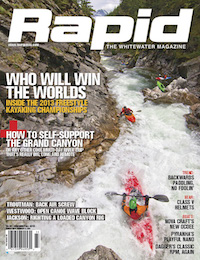 This article first appeared in the Summer/Fall 2013 issue of Rapid Magazine. For more great content, subscribe to Rapid’s print and digital editions here
This article first appeared in the Summer/Fall 2013 issue of Rapid Magazine. For more great content, subscribe to Rapid’s print and digital editions here
War of the Worlds: 2013 Freestyle World Championships
Freestyle kayaking was called rodeo when Eric Jackson, a 29-year-old Olympic slalom paddler, piloted a Dagger Transition through a series of flat spins, enders and pirouettes to win the 1993 world championships at Hell Hole on Tennesee’s Ocoee River. Looking back, the event was pivotal in redefining whitewater. Manufacturers like Dagger, Perception, Prijon, Pyranha and Eskimo created new, rodeo-specific designs specifically for the competition, launching the evolution of playboats; Jackson became a legend; and freestyle was born. “We can credit the growth of whitewater kayaking in the U.S. to the 1993 Worlds to a large degree,” says Jackson.
Jackson expects another inflection point this September when the world’s best freestyle kayakers and canoeists finally return to U.S. soil for the International Canoe Federation’s Freestyle World Championships at Bryson City, in North Carolina’s Nantahala Gorge, September 2 to 8. More than 250 of the top boaters from around the world are expected to compete on a $195,000, custom- built feature called the 2013 Wave.
The weeklong event will showcase the harmony of athleticism and freeform creativity that defines freestyle paddling. The field of competitors is astoundingly deep in both men’s and women’s K1 divisions, as well as open canoe. After preliminary rounds and semi-finals, the world’s best will have three 45-second rides to score points in the finals.
In men’s K1, 2009 world champion Nick Troutman says a routine involving “at least McNasties left and right, phonix monkeys left and right, a couple of either loops or space godzillas and a couple of tricky woos and lunar orbits will be linked at minimum” to win. On the women’s side, defending world champion Claire O’Hara expects to perform a basic routine of loops, felixes and cartwheels, “with McNasties, phonixes, space godzillas and split combos now being the crux moves.” Similarly in OC-1, aerial tricks and combinations such as McNasties, phonixes and maybe even a loop will crown the world champion.
More important than the athletes’ performances, insists Jackson, is the legacy of the 2013 competition. It’s hard to believe it’s been 20 years since the Ocoee rodeo, and harder still to realize that not one biannual world championship
has been held on U.S. soil since. In the meantime, a Jackson dynasty has emerged, freestyle kayak design has morphed and hole- and wave-riding tricks have evolved from rough-edged maneuvers to polished acrobatics. The southeastern U.S. has emerged as a global hotbed of kayak manufacturing and its legion of paddlers is whitewater’s stronghold. “The impact of the world championship being held in North Carolina is going to be huge,” says Jackson. “We, as paddlers, will be better off as the companies focus their energies on making better boats and truly connecting with the sport out on the river again.”
TEAM JACKSON
Perennial favorites at any freestyle event, Jackson Kayaks factory team athletes Eric and Dane Jackson, as well as their in-law, Troutman, could parlay home turf advantage into owning the 2013 men’s K1 podium at Nantahala. Dane enters his first senior world championships having dominated the junior division at the 2011 event with scores that would’ve earned him a top spot amongst the seniors. The diminutive 20-year-old has been likened to a miniature version of his father, Eric, for his innate paddling skills—his ability to throw explosive aerials and link tricks creatively on the fly, while exuding the Jacksons’ trademark competitive spirit. “He’s got more skills than balls,” says Troutman.
Veteran Jackson athlete Stephen Wright, who narrowly missed the cut at the U.S. team trials in late April, says Dane and 2009 world champ Troutman are the obvious paddlers to watch amongst senior men. Troutman, 25, says he’s working on developing the mental fortitude to perform under pressure and is dedicating the summer to getting to know the intricacies of the 2013 Wave. But Wright says don’t discount EJ, 49, who’s looking to win his fifth world championship crown. “EJ always has a chance to win,” says Wright. “He can make magic happen in a lot of situations that people wouldn’t expect. He can focus like nobody else, and he’s really driven by competition.”
On the women’s side, despite a valiant effort, Emily Jackson, then seven months pregnant, failed to make the U.S. team. That means Canadian Ruth Gordon Ebens will anchor Jackson Kayaks’ women’s roster. Gordon Ebens, 32, is a force to be reckoned with—she was runner-up at the 2011 Worlds and turned heads at the 2012 World Cup, scoring an impressive 495-point ride in the finals before finishing fourth overall. “She has the big moves and really performs consistently well at big events,” notes O’Hara, who will be defending her title.
THE WORLD
When British paddlers James Bebbington and O’Hara climbed to the top of the podium in the men’s and women’s K1 competition, respectively, at the 2011 World Championships in Plattling, Germany, it heralded a significant change in the psyche of elite freestyle paddlers. Both brought an Olympic athlete’s formal, highly ritualized training approach to freestyle kayak, as opposed to the freeform, laissez-faire mindset that’s more pervasive in North American paddlers. O’Hara, for instance, spent four years working with a volunteer support crew including two coaches, three video analysis experts, physiotherapists and a masseuse, sports psychologist, personal trainer, and a strength and conditioning trainer. “It used to be you just had to be a boater,” said O’Hara in an interview after her 2011 gold medal performance. “Now you have to be an athlete.”
O’Hara has kept up her rigorous programming and with her main rival, Emily Jackson, out of the competition, she’s a shoe-in to continue her dominance on the women’s side. O’Hara spent the winter and spring training around the world, including Great Britain, Africa, New Zealand and Australia. “She used the past year to travel and paddle, paddle, paddle,” says Gordon Ebens, “and she knows what it takes to be on top.”
O’Hara, 31, put on a clinic at the final 2012 World Cup event at Nantahala, adds Gordon Ebens, hitting high-scoring McNasties and phonixes, notching big-air bonuses and linking moves in combination for a record-setting high score of 633. “I think the key thing is that I need to be ready,” says O’Hara. “I need to get my training in early so that I feel happy with the feature and with my moves and then I can just go out and throw down and enjoy the event.”
Another veteran European, Slovakia’s Nina Csonkova, will challenge O’Hara and Gordon Ebens. Csonkova, who consistently makes the finals of most international events, finished third in the 2012 World Cup, and has been training hard this year, notes O’Hara. “Nina now has the competition experience and knows what it takes to win,” adds Gordon Ebens. “She has the tricks.”
European men tend to focus on precise angles and verticality, compared to the North American tendency to favor big air and linking moves, according to Wright. Besides Bebbington, a big-air threat who finished a disappointing seventh in last year’s World Cup, speedy Spaniard Joaquim Fontane and Pole sharp-shooter Tomasz Czaplicki are contenders on the men’s side. Perhaps the greatest European contender is Slovakian powerhouse Peter Csonka, the defending World Cup champion and Plattling runner-up, who appears poised to take a run at world championship glory. “He’s like a machine,” says Wright. “He’s physically stronger than anyone else and he can wing almost any tricks through strength alone.”
According to Troutman, the growing number of freestyle paddlers from the other side of the pond has made for an excess of medal contenders. “To try to list the top 10 paddlers is impossible now,” he says. “The top contenders are so close to each other, even making semi-finals is becoming a big deal.”
OUTSIDERS
Back for another kick at the can is 39-year-old Ottawa River local Billy Harris, a stalwart on the Canadian freestyle team who has placed as high as second in four previous world championships. “He knows what it takes, how hard you need to train and all the mind games that come with competition,” says Troutman. “But Billy brings more to the team than just experience and age. He has an amazing ability to teach kids…he was one of my biggest mentors.” Another dark horse is all-around boater Jason Craig, who bounced back from a major spinal cord injury to finish a solid third in the final stage of the 2012 World Cup. Craig placed fourth in the highly competitive U.S. team trials in April. And though he’s best known as a video boater with Demshitz, Wright says Mike Patterson showed well at the U.S. team trials and could turn heads in September.
American hopes in the women’s competition will rest with self-proclaimed “paddling nomad” Haley Mills, who parked her RV in North Carolina last winter and demonstrated her mastery of the 2013 Wave by winning the U.S. team trials in less than optimal high-water conditions. Mills finished fifth in 2011 in Plattling. “She’s learning the competitive ways,” says Gordon Ebens, “and this solid winter of training might be what she needed to get on top.”
UP AND COMERS
Future stars like Canadian Adam Chappell, Briton Bren Orton, and Ireland’s Billy Brett and David McClure will make their first appearances in the senior K1 division this year. Chappell impressed in last year’s Canadian team trials, says Troutman, but he’ll need to demonstrate his outstanding skills consistently and under pressure through multiple rounds of competition. The same goes for Orton, whom Wright describes as a prodigy with the ability to come up with high-scoring combinations off the cuff.
Two French paddlers could make waves in the women’s competition. Marlene Devillez is the defending European champion and is known for throwing huge tricks when the chips are down. Whitewater Grand Prix 2012 champ and former junior freestyle gold medalist, Nouria Newman’s “raw paddling talent” makes her a threat in any kayaking discipline, according to O’Hara. More of a long shot, young Japanese boater Hitomi Takaku could also turn heads.
OPEN BOATERS
Even the top athletes will admit that OC-1 freestyle is largely a crapshoot, with huge potential for dark-horse boaters coming out of the woodwork and putting up big rides. “OC-1 has more of an element of randomness than the decked boats,” says veteran competitor and game-changing Blackfly Canoes designer Jeremy Laucks, “so it can really be anyone’s game.”This bodes well for Canadians Matt Cuccaro and Vincent Dupont.
With only two spots on the U.S. team up for grabs, Laucks and 2012 World Cup champ Seth Chappelle were unseeded by Dane Jackson and Jordan Poffenberger. Laucks says Poffenberger has been at the forefront of OC-1’s rapid progression by hitting tough, high-scoring moves like McNasties, and Jackson won the 2011 junior world championships. Meanwhile, Laucks expects Spain and Germany to field powerhouse teams (Spaniards Adria Bosch and Odei Areta won gold and silver in 2011), and perhaps a few well-established C-1 boaters to make a crossover.
Conor Mihell has been chasing the world championships for Rapid since 2009.
 This article first appeared in the Summer/Fall 2013 issue of Rapid Magazine. For more great content, subscribe to Rapid’s print and digital editions here
This article first appeared in the Summer/Fall 2013 issue of Rapid Magazine. For more great content, subscribe to Rapid’s print and digital editions here




